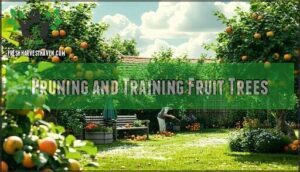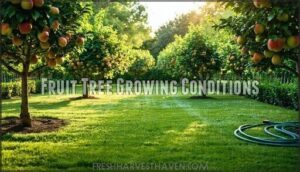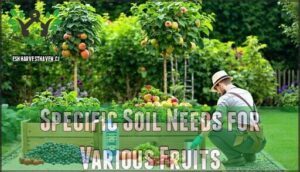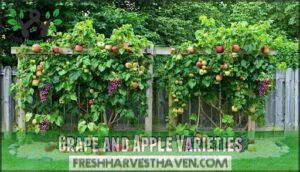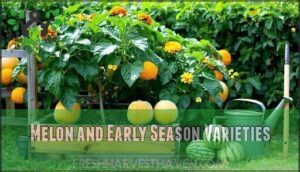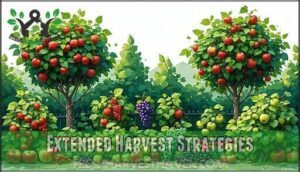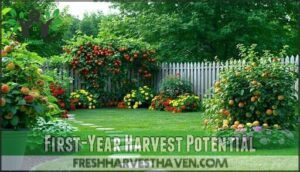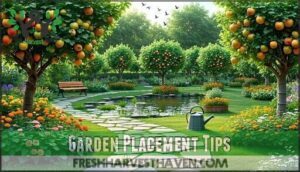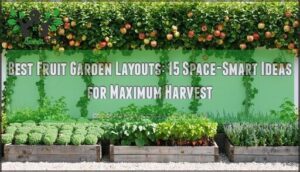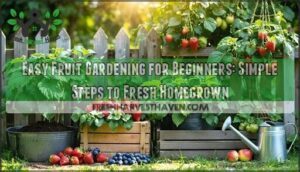This site is supported by our readers. We may earn a commission, at no cost to you, if you purchase through links.
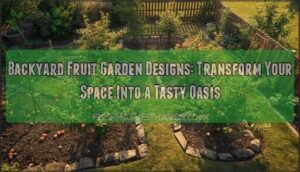 You’ll create productive backyard fruit garden designs by placing dwarf trees in sunny spots with 6-8 hours of direct light, grouping plants by water needs, and positioning berry bushes as natural borders.
You’ll create productive backyard fruit garden designs by placing dwarf trees in sunny spots with 6-8 hours of direct light, grouping plants by water needs, and positioning berry bushes as natural borders.
Strategic layout maximizes your harvest while maintaining easy access for pruning and picking. Consider microclimates, soil drainage, and mature plant sizes when planning your edible landscape.
Smart spacing prevents overcrowding and disease issues that plague cramped gardens. Your fruit garden becomes a year-round food source when you select varieties with staggered ripening times and integrate them seamlessly with existing landscaping features for both beauty and function.
This approach ensures that your garden is not only productive but also visually appealing, with a focus on easy access for maintenance and staggered ripening times to extend the harvest season, ultimately creating a beautiful landscape.
Table Of Contents
- Key Takeaways
- Fruit Garden Planning
- Plant Selection Guide
- Fruit Varieties Selection
- Garden Placement Tips
- Maintenance Considerations
- Frequently Asked Questions (FAQs)
- How do you plan a backyard fruit garden?
- What makes a good fruit garden layout?
- How do you grow fruit in a backyard?
- How do you create a fruit garden layout?
- What makes a good fruit garden?
- Can you make a mini fruit garden for your front yard?
- What fruits cannot be planted together?
- What is the easiest fruit to grow in your backyard?
- What are the Best Backyard Orchard ideas?
- Can you grow fruit in a small garden?
- Conclusion
Key Takeaways
- Map your sunlight patterns first – You’ll need 6-8 hours of direct sun daily for most fruit trees, so track the light throughout your yard before choosing locations for maximum productivity.
- Choose dwarf varieties and space strategically – You can fit productive orchards in small spaces by selecting compact trees, using espalier techniques, and maintaining 8-10 feet between dwarf fruit trees.
- Group plants by water needs and create easy access – You’ll save time and improve plant health by clustering similar-care plants together and designing pathways that connect high-traffic areas to harvest zones.
- Plan for staggered harvests and proper maintenance – You’ll extend your growing season by selecting early, mid, and late-ripening varieties while establishing regular pruning schedules to prevent disease and maximize yields.
Fruit Garden Planning
Planning your backyard fruit garden starts with understanding your space’s unique conditions and selecting the right miniature garden type for maximum productivity.
You’ll need to map sunlight patterns, verify water accessibility, and choose from container gardens, espalier systems, or vertical growing methods that fit your available area.
Types of Miniature Fruit Gardens
Space constraints shouldn’t limit your fruit-growing dreams. Miniature fruit gardens transform even postage-stamp yards into productive orchards through clever design strategies.
Container Gardens house compact fruit trees on patios using large pots. Espalier Designs train trees flat against walls, creating living art. Vertical Orchards maximize height with trellised vines and climbing varieties. Miniature Landscapes combine multiple techniques for maximum productivity.
Here’s your space-to-fruit guide:
- Narrow strips (2-3 feet): Espalier fruit trees and trellised grapes
- Small beds (4 feet): Dwarf varieties and berry bushes
- Tiny spots (2×2 feet): Pruned gooseberries and compact plants
- Patio spaces: Container gardens with dwarf fruit trees
When planning a miniature fruit garden, understanding soil preparation tips is vital for healthy growth and productivity.
Designing The Garden for Optimal Sunshine
Sunlight mapping transforms your yard into a productive oasis by revealing those golden 6-8 hours your fruit trees crave. You’ll want to track morning sun patterns first—they’re your garden’s wake-up call for photosynthesis.
Smart garden orientation places heat-loving peaches where they’ll catch maximum sunlight, while shade-tolerant berries thrive under partial cover. Fruit tree spacing prevents neighborly squabbles over light, giving each tree breathing room to flourish.
Here’s your sunlight mapping cheat sheet:
| Garden Zone | Sun Hours | Best Fruits |
|---|---|---|
| Full Sun (6-8 hrs) | Morning-afternoon | Peaches, apples, grapes |
| Partial Sun (4-6 hrs) | Morning-midday | Pears, plums, cherries |
| Filtered Light (2-4 hrs) | Dappled shade | Berries, currants |
Solar access isn’t just about placement—it’s about timing. Morning sun dries dew quickly, preventing fungal diseases that love moisture. Shade management means pruning strategically and using reflective mulch to bounce light onto lower branches, maximizing your backyard fruit garden designs potential.
Proximity to Water and Frequent Visits
Your backyard fruit garden designs need strategic water placement and regular attention to thrive. Position your water source within 50 feet of planting areas—dragging heavy hoses across the yard gets old fast.
Garden accessibility directly impacts your visitation frequency, which determines harvest success. Smart irrigation tips transform maintenance from chore to pleasure.
- Install drip irrigation system lines near high-maintenance berry patches
- Create gravel pathways that won’t turn muddy during watering sessions
- Position garden benches where you’ll naturally observe plant health
- Store tools within easy reach of your main growing areas
- Use timer-controlled systems to maintain consistent soil moisture
Fruit tree spacing should accommodate both mature canopy size and irrigation coverage. Daily visits become second nature when everything’s conveniently located. You’ll catch pest problems early, monitor ripening fruit, and enjoy the therapeutic ritual of garden care. Remember, neglected fruit trees produce disappointing harvests—proximity breeds productivity.
Plant Selection Guide
Choosing the right plants forms the foundation of your productive fruit garden, requiring careful consideration of your specific growing conditions and space limitations.
Success depends on matching each fruit variety to your soil type, climate zone, and available sunlight while understanding proper care techniques for maximum yields, which includes recognizing the importance of complete concepts in garden planning.
Pruning and Training Fruit Trees
Proper tree pruning transforms your backyard into a productive paradise. Fruit tree pruning during dormancy stimulates vigorous spring growth, while branch thinning improves light penetration and air circulation.
Master espalier techniques to maximize small spaces—these fruit training methods create stunning living walls. Sharp pruning shears guarantee clean cuts that heal quickly.
Understanding pruning fruit trees is essential for a healthy and productive garden.
| Training Method | Best For | Benefits |
|---|---|---|
| Central Leader | Apples, Pears | Strong structure, easy harvest |
| Open Center | Peaches, Plums | Maximum sunlight exposure |
| Espalier | Small spaces | Decorative, space-efficient |
| Modified Leader | Most fruits | Balanced growth, high yields |
Root pruning at planting establishes healthier systems. Stem grafting combines varieties for extended harvests.
These pruning techniques reduce disease risk by 37% while boosting yields substantially.
Berry Growing and Care
While berry bushes might seem like simple fruit shrubs, they’re actually sophisticated plants requiring specific care.
Here’s your roadmap to berry growing success:
- Test berry soil pH levels between 4.5-5.5 for blueberries, 6.0-6.5 for raspberries
- Apply specialized berry fertilizer in early spring before new growth emerges
- Master berry pruning techniques – remove dead canes and thin overcrowded areas
- Monitor for common fruit pests like spotted wing drosophila and aphids
- Plant pollinator plants nearby to boost yields naturally
These compact options transform small spaces into productive berry patches with proper attention.
Understanding the role of berry fertilizer is vital for ideal berry growth and development.
Fruit Tree Growing Conditions
Most fruit trees thrive when you create ideal growing environments suited to their specific needs.
Understanding these fundamental requirements guarantees your backyard orchard flourishes regardless of your experience level.
- Sunlight Hours: Position trees where they’ll receive 6-8 hours of direct sunlight daily for maximum photosynthesis and fruit development.
- Soil Quality: Select well-draining locations with pH levels between 6.0-7.0 to prevent root rot and nutrient deficiencies.
- Air Circulation: Space dwarf fruit trees 8-10 feet apart to promote airflow and reduce fungal disease risks.
- Water Source: Establish proximity to reliable irrigation within 50 feet for consistent deep watering without oversaturation.
Specific Soil Needs for Various Fruits
Testing your soil pH levels first saves you from future headaches.
Organic matter becomes your secret weapon—blueberries demand acidic conditions around 4.5-5.5, while apples flourish in neutral 6.0-7.0 ranges.
Soil composition matters tremendously: citrus trees crave well-drained soil with sandy textures, whereas berries need moisture-retentive ground rich in compost.
Address nutrient deficiencies early with targeted fertilizer types.
Poor soil drainage kills more trees than drought does.
Smart soil health management means understanding each variety’s unique soil needs before planting.
Accurate soil analysis requires using a soil pH tester to determine the ideal conditions for your fruit garden.
Fruit Varieties Selection
Selecting the right fruit varieties transforms your backyard into a productive harvest haven that delivers fresh produce from spring through fall.
You’ll want to balance early-ripening cultivars with extended-season varieties to maximize your growing space and guarantee continuous fruit production throughout the growing season.
Grape and Apple Varieties
Selecting the right grape types and apple cultivars transforms your space into a productive paradise.
Es palier apple varieties like ‘Honeycrisp’ and ‘Granny Smith’ thrive in vertical training systems, while disease-resistant grape varieties such as Concord excel on trellises.
Smart fruit pairing maximizes your harvest timing across seasons.
- Dwarf fruit trees like compact apple cultivars fit tight spaces perfectly
- Grape varieties with natural disease resistance reduce maintenance headaches
- Vertical training systems double your fruit production per square foot
- Apple varieties with overlapping bloom times guarantee better pollination success
- Fruit tree varieties selected for your climate zone guarantee reliable harvests
Melon and Early Season Varieties
Two melon varieties excel in backyard gardens: Jenny Lind cantaloupe ripens in 70 days, perfect for compact spaces.
Early Harvest begins with proper Seed Selection and Soil Warmth preparation. Melon Care includes consistent watering and Fruit Thinning for larger specimens.
Plant marigolds nearby for natural pest control. These dwarf fruit trees alternatives thrive in miniature fruit gardens, offering sweet rewards without requiring extensive space or complex espalier techniques.
Extended Harvest Strategies
A symphony of flavors awaits when you master succession planting and staggered harvest techniques.
Strategic crop rotation keeps your garden productive for months beyond traditional timelines.
- Succession planting berry bushes every 3-4 weeks creates continuous harvests from June through October
- Staggered varieties of apples (early, mid, late-season) extend picking from July into November
- Season extension with row covers protects late-ripening grapes from autumn frost damage
- Harvest scheduling combines short-season strawberries with longer-maturing tree fruits for maximum overlap
- Microclimate manipulation using south-facing walls accelerates ripening by 2-4 weeks earlier
This extended harvest approach transforms your backyard into a year-round fruit production powerhouse.
First-Year Harvest Potential
You’ll enjoy immediate rewards with Fast Growing Fruits like strawberries and blackberries that produce substantial Early Yield within months of planting.
These quick producers keep you motivated while your fruit tree growing conditions establish long-term success.
Dwarf fruit trees offer compact options for backyard fruit garden designs, delivering firstyear harvest when you optimize Harvest Timing and Crop Density.
Garden Placement Tips
Strategic placement determines your fruit garden’s success rate and productivity levels. You’ll need to evaluate microclimates, frost patterns, and sun exposure while ensuring convenient access for daily maintenance tasks.
Smart placement beats luck every time when creating productive fruit gardens that thrive for decades.
Avoiding Frost Pockets and Late Frost Damage
Throughout winter’s harsh grip, frost pockets can devastate your fruit garden’s potential harvest. Smart microclimate analysis helps you identify these temperature traps before planting vulnerable varieties. Cold air settles in low-lying areas, creating frost pockets that damage blossoms and young growth.
Strategic frost protection transforms risky locations into productive growing spaces:
- Plant on slopes – Elevated positions allow cold air to drain away from your trees naturally
- Install soil insulation – Mulch and cold frames maintain warmer root zones during temperature drops
- Create windbreaks – Permeable barriers redirect freezing air while maintaining beneficial airflow
Effective winter garden preparation is vital for protecting your fruit garden from frost damage. Your winter care strategy should include monitoring tools and protective covers for unexpected temperature swings.
Location for Sunshine and Accessibility
After avoiding frost damage, you’ll want to master sunlight mapping for ideal fruit production. Your backyard fruit garden designs depend on identifying those golden 6-8 hours of direct sunlight daily.
Walk your yard with a notebook, tracking sun patterns from dawn to dusk across seasons. Smart garden layout positioning places sun-loving fruit trees in southern exposures while accounting for existing structures that create shade.
Design pathways that connect high-traffic areas to harvest zones, ensuring you won’t trudge through mud during berry season. Consider microclimates where heat reflects off walls or cool pockets form near fences.
- Sunlight mapping reveals prime real estate for fruit production
- Pathway design connects kitchen to harvest zones efficiently
- Accessibility features like wider walks accommodate wheelbarrows and ladders
- Soil testing near water sources simplifies irrigation planning
Adding a Fruit Hedge for Privacy
You can create natural privacy screens using edible plants that serve double duty.
Pomegranate bushes form dense garden borders while producing antioxidant-rich fruit, and blueberry hedges offer seasonal color plus berries.
These fruit hedge options beat traditional fence options by providing food alongside privacy.
Plant dwarf apple varieties or elderberries as living yard dividers that’ll give you fresh harvests.
Your backyard orchard becomes both sanctuary and pantry with these smart fruit garden design choices.
Maintenance Considerations
You’ll need to monitor pruning, pest management, and soil health to keep your fruit garden productive and disease-free.
Don’t worry—routine care means fewer surprises and more apples for your pie, with routine care being the key to a successful harvest.
Regular Pruning and Training
Three key pruning techniques transform your backyard trees into productive powerhouses.
Regular pruning and training fruit trees boosts yields while preventing disease through improved airflow. Master these fundamentals for healthier, more manageable trees.
Essential pruning and training practices include:
- Pruning Tools: Select sharp garden shears and pruning shears for clean cuts
- Tree Training: Guide young branches into proper structure using gentle bending techniques
- Fruit Thinning: Remove excess fruit clusters to prevent branch breakage and improve quality
- Branch Cutting: Eliminate crossing, dead, or diseased wood during dormant seasons
- Pruning Techniques: Make angled cuts above outward-facing buds to encourage proper growth
Quality pruning tools make precise cuts that heal quickly and reduce infection risk. Proper pruning techniques often rely on using the right pruning shear tools for the job.
Organic Growing and Integrated Pest Management
Breaking free from chemical dependency starts with building robust soil health through organic fertilizers and companion planting.
You’ll boost natural pest control by attracting beneficial insects with diverse flowering plants—marigolds deter nematodes by 40%, while herbs like dill attract predatory insects that slash aphid populations by 80%.
Natural mulch retains moisture and suppresses weeds without chemicals.
Integrated pest management combines sticky traps, beneficial predators, and organic growing practices.
This balanced approach creates a thriving ecosystem where your fruit trees flourish naturally, reducing pest control interventions by over 50% while maintaining healthy harvests.
Mitigating Common Problems and Specialty Trees
Beyond organic treatments, specialty fruit trees require targeted disease resistance strategies and proper tree support systems.
Pest control becomes manageable when you monitor for fruit pests weekly and maintain adequate shade management around dense canopies.
Here’s how specialty fruit tree care transforms your backyard fruit garden designs:
- Espalier trees need horizontal wire supports every 18 inches to prevent branch breakage
- Multi-graft varieties require careful pruning to balance different cultivars’ growth rates
- Dwarf rootstocks demand consistent moisture monitoring since shallow roots dry faster
Address fruit tree problems early through proper spacing and air circulation.
Managing Fruit Production and Waste Prevention
Managing excessive fruit production becomes essential once your backyard orchard hits peak productivity. Smart harvest timing and proper crop rotation maximize fruit yield while supporting soil conservation through sustainable gardening practices.
Understanding the importance of a well-planned fruit harvest schedule is key to maintaining a balanced and thriving orchard.
- Preserve surplus harvests through freezing, canning, or dehydrating to extend your homegrown bounty throughout winter months
- Share with community networks including neighbors, local food banks, or farmer’s markets to prevent waste while building relationships
- Transform overripe fruit into compost, jams, or fermented beverages that support ongoing fruit tree maintenance cycles
- Plan staggered plantings and diverse varieties to spread harvest periods, reducing overwhelming peaks in fruit production
Frequently Asked Questions (FAQs)
How do you plan a backyard fruit garden?
Transforming your yard into a fruitful paradise starts with selecting the perfect sunny location with 6+ hours of daily sunlight.
Choose climate-suited varieties, plan pathways for maintenance access, and consider companion planting for enhanced biodiversity and natural pest control.
What makes a good fruit garden layout?
You’ll create ideal fruit production by positioning trees with 6-8 hours of sunlight and proper spacing.
Combine dwarf varieties, espalier techniques, and companion planting to maximize yields while maintaining easy access pathways.
How do you grow fruit in a backyard?
You don’t need acres—just smart planning and the right varieties.
Start with dwarf fruit trees in 8-foot spacing, choose climate-suited species, guarantee six hours daily sunlight, and add companion plants for natural pest control.
How do you create a fruit garden layout?
Start by mapping your space and identifying areas with 6-8 hours of daily sunlight.
Plan pathways, place larger trees toward the back, and group compatible varieties together for ideal pollination and maintenance access.
What makes a good fruit garden?
Forget the myth that fruit gardens demand acres—you’ll create thriving harvests in compact spaces with proper planning, ideal sunlight, suitable varieties, and consistent care practices.
Can you make a mini fruit garden for your front yard?
You’ll transform your front yard into a productive mini orchard using dwarf fruit trees, espalier techniques, and container gardening.
Dwarf varieties require only 8-10 feet spacing and reach maturity in 3-5 years.
What fruits cannot be planted together?
Black walnut trees can’t be planted near most fruits because they release juglone, a chemical that’s toxic to apples, pears, and stone fruits, causing stunted growth and death.
What is the easiest fruit to grow in your backyard?
Like a gardener’s best friend, strawberries spread easily and forgive mistakes—they’re your gateway to backyard fruit success.
You’ll harvest sweet berries within months, as these hardy perennials thrive in most climates with minimal care required, making them a great choice for those looking for easy gardening experiences.
What are the Best Backyard Orchard ideas?
Start with dwarf varieties and espalier techniques to maximize your space efficiently. You’ll create stunning edible landscapes using vertical trellises, companion planting, and strategic tree placement for year-round harvests.
Can you grow fruit in a small garden?
You’ll be amazed how dwarf varieties and espalier techniques transform tiny spaces into productive havens. Container gardening, vertical trellises, and companion planting maximize every square foot effectively.
Conclusion
Successfully transforming your outdoor space begins with understanding that the best backyard fruit garden designs combine scientific planning with practical accessibility.
Your carefully positioned dwarf trees will create natural microclimates while berry bushes establish living boundaries that produce food year-round.
You’ll discover that proper spacing, strategic plant selection, and thoughtful maintenance schedules turn ordinary yards into productive landscapes that deliver fresh harvests from spring through fall, proving that functional gardens can be beautiful too, and ultimately create a productive landscape.
- https://www.finegardening.com/project-guides/pruning/espalier?srsltid=AfmBOooHL9GKh_k8zMAFIh_tseoPAMOv9YnQVxWcetgACWUi-pKjx2du
- https://www.agriwebb.com/blog/how-to-improve-soil-health/
- https://learn.colincanhelp.com/companion-planting-with-garlic/
- http://www.davewilson.com:8080/home-gardens/backyard-orchard-culture/photos
- http://www.youtube.com/user/davewilsontrees

